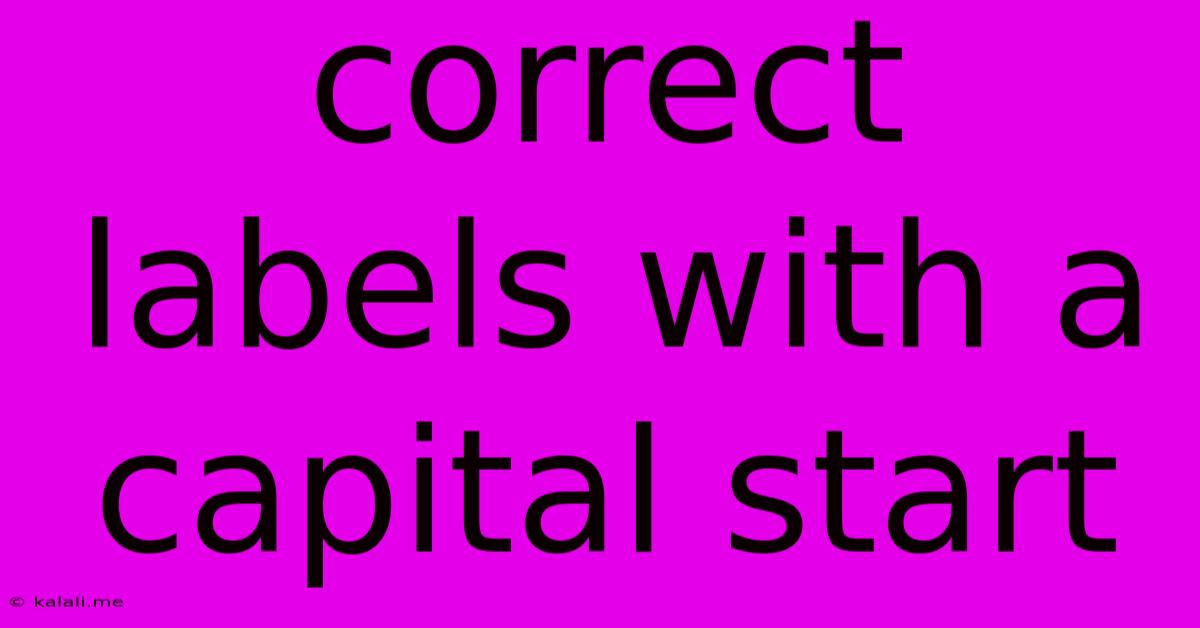Correct Labels With A Capital Start
Kalali
May 21, 2025 · 3 min read

Table of Contents
Capitalization: Mastering the Art of Correct Labels
Capitalization might seem like a minor detail, but getting it right significantly impacts readability and professionalism. Inconsistent capitalization can make your writing look sloppy and unprofessional, hindering effective communication. This article dives deep into the rules and nuances of capitalization, focusing specifically on correctly capitalizing labels, ensuring your writing shines. We'll cover various types of labels and provide clear examples to solidify your understanding.
Understanding the Basics of Capitalization
Before tackling labels, let's refresh the fundamental rules of capitalization. Generally, we capitalize:
- The first word of a sentence: This is the most basic rule. Always begin a sentence with a capital letter.
- Proper nouns: This includes names of people, places, organizations, and specific brands. For example, John, London, Google, and Toyota.
- Days of the week and months: Monday, Tuesday, January, February, etc.
- Holidays: Christmas, Thanksgiving, Hanukkah.
- Titles of books, articles, and songs: The Great Gatsby, How to Write a Blog Post, Bohemian Rhapsody.
Capitalizing Different Types of Labels
Now, let's focus on the specific application of capitalization to various labels:
-
Labels in Headings and Subheadings: Capitalize all major words (nouns, pronouns, verbs, adjectives, adverbs) in headings and subheadings. Articles (a, an, the), prepositions (of, in, on), and conjunctions (and, but, or) are generally lowercase unless they are the first or last word.
- Example: "Understanding the Importance of Proper Capitalization" (correct) vs "Understanding the importance of proper capitalization" (incorrect)
-
Labels in Lists: Capitalize the first word of each item in a list, especially if the list items are complete sentences. If the items are short phrases, capitalization is optional but maintaining consistency is key.
- Example:
- Complete Sentences: "Implement a strong SEO strategy." "Create high-quality content regularly."
- Short Phrases: "Keyword research," "On-page optimization," "Link building" (consistent capitalization is preferred).
- Example:
-
Labels in Tables and Charts: Similar to lists, capitalize the first word of each label in tables and charts. Consistency is crucial for clear presentation. Capitalize column and row headers as if they were headings.
-
Labels in Diagrams and Images: Capitalize all significant words in labels used within diagrams, flowcharts, or images to maintain visual clarity and professionalism. Adhere to the same rules as headings.
-
Labels in Forms and Applications: All labels in forms and applications should be capitalized consistently. This ensures easy navigation and understanding for users.
-
Labels in Code: Capitalization in code follows specific language conventions. Some languages are case-sensitive, while others aren't. Always adhere to the style guide of the specific programming language you are using. This often involves consistent capitalization of classes, variables, and functions.
Avoiding Common Capitalization Mistakes
- Over-capitalization: Avoid capitalizing every word. This creates an unnatural and visually jarring effect.
- Inconsistent capitalization: Maintain a consistent style throughout your document.
- Incorrect capitalization of proper nouns: Double-check the spelling and capitalization of names, places, and organizations.
- Misuse of capitalization in lists and labels: Be mindful of the context and apply the appropriate capitalization rules for lists, tables, and other elements.
Conclusion
Mastering correct capitalization, particularly in labels, enhances your writing's professionalism and readability. Following these guidelines ensures clear and consistent communication, both for yourself and your audience. By understanding the rules and nuances, you create polished and impactful content. Remember, attention to detail matters, and proper capitalization is a significant component of quality writing.
Latest Posts
Latest Posts
-
How Do You Get Dried Blood Out Of Carpet
May 21, 2025
-
Water Heater Pressure Relief Valve Dripping
May 21, 2025
-
How Does Voldemort Hold His Wand
May 21, 2025
-
How Long Will A Thermos Keep Water Hot
May 21, 2025
-
What Is The Opposite Of Yellow
May 21, 2025
Related Post
Thank you for visiting our website which covers about Correct Labels With A Capital Start . We hope the information provided has been useful to you. Feel free to contact us if you have any questions or need further assistance. See you next time and don't miss to bookmark.